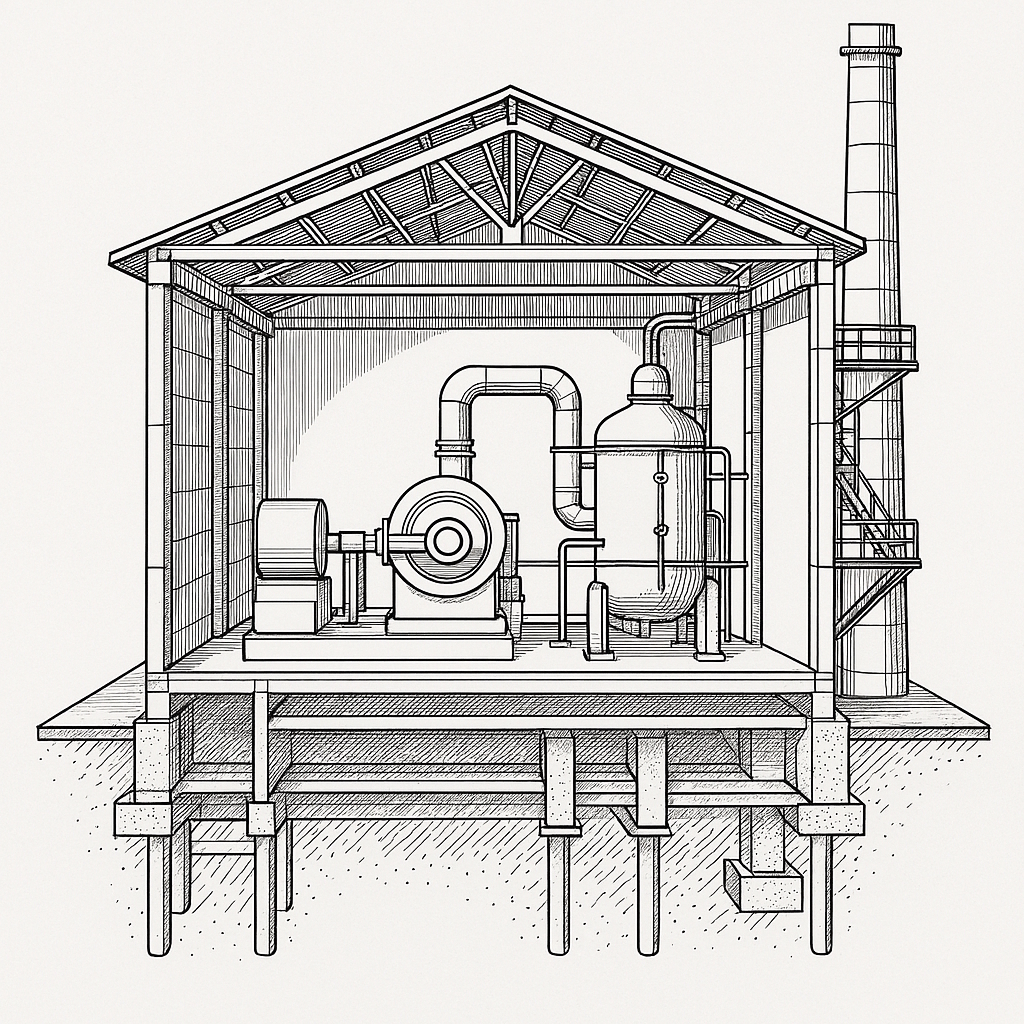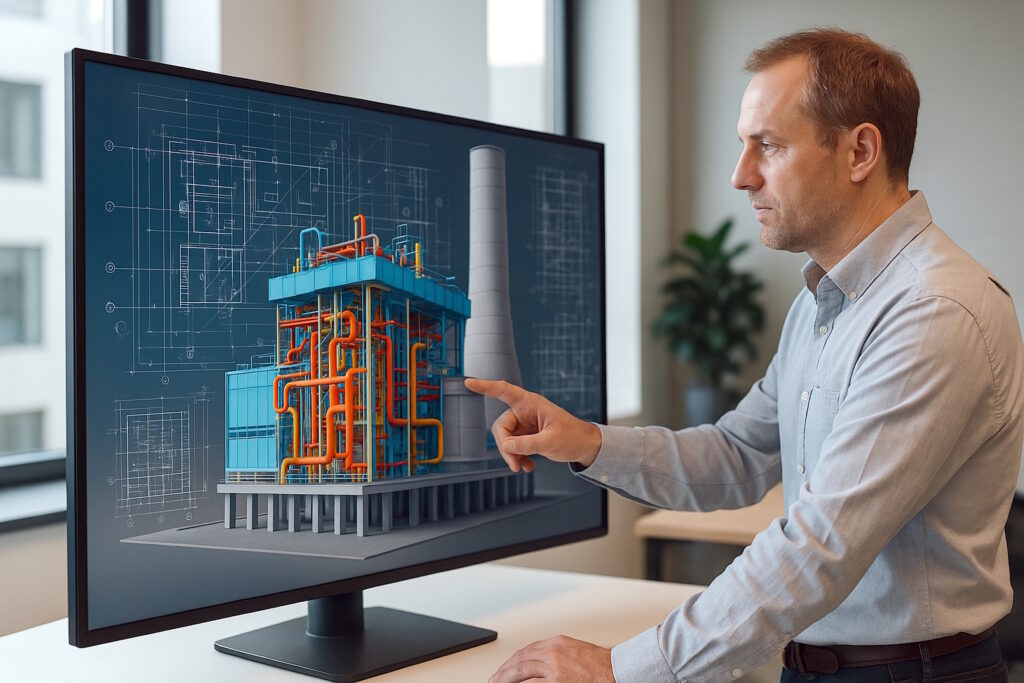Introduction
Power plants don’t rise from blueprints alone—they’re forged through the precision of structural engineering, a discipline that balances towering ambitions with unyielding realities. These facilities, pulsing with energy, demand more than generic construction know-how. They require firms that understand seismic forces, anchor colossal equipment, and intricate systems into a cohesive whole. Choosing the right structural engineering firm isn’t a checkbox exercise; it’s a strategic alignment of expertise, vision, and execution.
A single oversight can lead to failures or inflated construction costs, choice of engineering firms a pivotal decision.
Role of Structural Engineering in Power Plant Projects
Structural engineers’ expertise plays an important role in every phase of power plant construction. Their skills in helps in designing robust buildings, bridges, towers, and other infrastructure to withstand heavy loads, environmental conditions, and different conditions. In power plant construction, structural engineering is not just about designing supports; it is about ensuring that every building, every tower, and every bridge is integrated into an efficient, secure, and sustainable system. This needs a commitment to sustainable development and the application of advanced technologies to meet the growing demands of urbanization and modern engineering challenges.

Safety and Security:
Structural engineering companies must adhere to safety standards that protect both workers and the community. When a firm works on critical infrastructure projects, the rigorous structural engineering they produce ensures long-term durability and minimal environmental impact.
Efficiency and Reliability: From power plants to power stations, the expertise of a structural engineering firm contributes to the efficiency and reliability of power systems. The process is driven by advanced civil engineering methods and continuous innovation, ensuring projects meet project requirements at any scale.
Innovation in Engineering:
Innovation in engineering is where the best structural engineering companies really shine. With technological advancements and innovative solutions, they drive the generation of resilient and cost-effective structures.
Key Considerations for Selecting a Structural Engineering Firm
When selecting a structural engineering firm, several key considerations can significantly impact the success of your power plant project. First and foremost, assess the firm’s experience and expertise in handling projects similar to yours. A firm with a proven track record of delivering high-quality results and a deep understanding of the latest industry trends and technologies is invaluable.
Another critical factor is the firm’s project management capabilities. A well-organized and efficient project management process ensures that your project is completed on time, within budget, and to the required quality standards. Effective communication skills and the ability to collaborate with other stakeholders, including architects, contractors, and clients, are also essential. This ensures that all parties are aligned and working towards the same goals.
Finally, consider the firm’s commitment to innovation and sustainability. A firm dedicated to staying at the forefront of industry developments and incorporating sustainable practices into their work is more likely to deliver a project that meets your needs and exceeds your expectations. By focusing on these key considerations, you can select a structural engineering firm that will drive the success of your power plant project.
Learn how digital integration with advanced rebar detailing and precast detailing can drive success.

Strategies For Selecting Structural Engineering Companies
So what makes a top-tier structural engineering firm for power plant projects? There are several factors to consider.
Expertise in Power Plant Construction
Specialized Knowledge:
Expertise in power plant construction is one of the most important. Look for companies that have demonstrated expertise in power plant construction and related infrastructures such as power stations. Their experience should span various scales—from small-scale power plants to large-scale energy plants. Power plants vary vastly in design requirements:
Nuclear plants demand seismic resilience (e.g., 0.3g ground motion resistance) and radiation containment.
Thermal plants require corrosion-resistant materials for boilers and chimneys operating at 500–600°C.
Renewable projects (solar/wind) need lightweight, weather-resistant frameworks.
The structural engineering industry continues to grow, evolving to meet the changing needs of society and driving innovation. Modern BIM integration supports these advanced design challenges.
Project Portfolio:
A strong portfolio that includes projects in power plants, bridges, buildings and infrastructure shows a firm can work under different environmental conditions and meet diverse project requirements. Look for firms with a proven record in engineering projects like bridges, towers and power plants. Notably, Arcadis, founded in the Netherlands, emphasizes its commitment to sustainable projects that enhance urban life. If a firm has worked on projects across the world and in the Middle East, Europe and North America, it demonstrates versatile knowledge in both civil engineering and structural design.
Advanced Technological Capabilities and Equipment
The companies you evaluate must use up-to-date technological advancements for drafting, 3D modeling and BIM integration.
Technology and BIM Integration:
The structural companies should use advanced structural design and drafting software, ranging from Tekla Structures and AutoCAD to Revit. These tools are essential for producing detailed shop drawings and project planning.
With software such as Tekla Structures, PROKON, RFEM, and S-FRAME, structural engineering companies can produce models that not only adhere to safety standards but ease the design process. These solutions ultimately lower construction costs and improve the efficiency of operations.
Collaboration is key:
Structural engineering companies must work closely with architects, contractors and civil engineering teams. This interdisciplinary process helps ensure that the entire project planning and execution process runs smoothly.
Real-Time Updates:
The integration of real-time data into BIM models allows project management teams and clients to monitor construction progress, adjust cost estimates, so the project planning aligns with the latest information.
See how expert CAD Design & Drafting Services streamline detailed designs.
Safety Standards and Sustainability
Adherence to Global Standards:
The best structural engineering companies strictly follow global/regional safety standards such as those by AISC, ISO, ACI, and ASCE. This ensures designs are compliant and safe to operate.
Regulatory adherence is non-negotiable in high-risk environments:
Nuclear: ASME BPVC Section III for reactor containment.
Thermal: ISO 13705 for chimney design.
Global Standards: IBC, Eurocodes, and local codes (e.g., UAE’s ADNOC guidelines).
Explore how BuildTwin helps power plant projects meet these standards >>
Sustainability Practices:
Structural engineering companies that truly excel in their field do more than just design buildings. They consider the environmental impact and sustainability of their projects from the very start. That means energy-efficient designs, materials that reduce the construction site’s environmental footprint and innovative solutions that drive efficiency.
Certification Check: Prioritize firms with LEED, BREEAM, or CEEQUAL accreditation.
Innovative Approaches
Firms with innovative solutions often use advanced materials and modern methods to contribute to sustainability while maintaining efficiency.
These solutions are essential for power plant construction where energy and environmental considerations play a key role.
Assessing a Firm’s Project Management Capabilities
Assessing a firm’s project management capabilities is a critical step in the selection process. Here are some key factors to consider:
- Project Planning: Does the firm have a clear and comprehensive project plan in place? Are the project goals, timelines, and budgets well-defined? Effective project planning is crucial for ensuring that the project progresses smoothly and meets all milestones.
- Communication: How does the firm communicate with clients and other stakeholders? Are they responsive to queries and concerns? Strong communication skills are vital for keeping all parties informed and aligned throughout the project.
- Risk Management: Does the firm have a robust risk management process in place? Are they able to identify and mitigate potential risks and issues? Effective risk management helps prevent problems and ensures that the project stays on track.
- Quality Control: What quality control processes does the firm have in place? Are they able to ensure that the project meets the required quality standards? Rigorous quality control is essential for delivering a high-quality, reliable power plant.
- Collaboration: How does the firm collaborate with other stakeholders, including architects, contractors, and clients? Are they able to work effectively as part of a team? Successful collaboration ensures that all aspects of the project are integrated seamlessly. BuildTwin’s integrated ERP solutions streamline project management and communication, know more.
By evaluating these factors, you can get a sense of the firm’s project management capabilities and whether they are well-equipped to handle your project.
The Benefits of Working with Elite Structural Engineering Companies
Working with an elite structural engineering company can bring numerous benefits to your project. Here are some of the advantages of partnering with a top-tier firm:
- Expertise: Elite structural engineering companies have a deep understanding of the latest industry trends and technologies. They bring this expertise to your project, ensuring that it is designed and built to the highest standards.
- Innovation: Top-tier firms are often at the forefront of industry developments, incorporating innovative solutions and sustainable practices into their work. This commitment to innovation can lead to more efficient and effective project outcomes.
- Quality: Elite structural engineering companies are committed to delivering high-quality results. They have robust quality control processes in place, ensuring that your project meets the required standards and performs reliably over time.
- Efficiency: Top-tier firms are often more efficient in their project management processes, ensuring that your project is completed on time and within budget. Their streamlined processes and experienced teams can help avoid delays and cost overruns.
- Reputation: Partnering with an elite structural engineering company can enhance your reputation and credibility. It demonstrates your commitment to quality and excellence, which can be beneficial for securing future projects and partnerships.
By working with an elite structural engineering company, you can ensure that your power plant project is executed with precision, innovation, and a commitment to quality.

Shortlisting and Evaluating Potential Firms
Once you have identified a list of potential structural engineering firms, it’s essential to shortlist and evaluate them further. Here are some steps to follow:
- Review the Firm’s Website and Marketing Materials: Get a sense of their expertise and experience by reviewing their online presence. Look for detailed information about their services, past projects, and areas of specialization.
- Check for Relevant Certifications or Accreditations: Certifications such as ISO 9001 or LEED AP indicate a commitment to quality and sustainability. These credentials can provide additional assurance of the firm’s capabilities.
- Evaluate the Firm’s Project Portfolio: Look for examples of similar projects and their success stories. A strong portfolio demonstrates the firm’s ability to handle projects of varying complexity and scale.
- Assess the Firm’s Project Management Capabilities: Use the factors outlined above to evaluate their project management processes. This includes planning, communication, risk management, quality control, and collaboration.
- Contact the Firm’s References: Ask for feedback on their experience working with the firm. This can provide valuable insights into the firm’s reliability, professionalism, and ability to deliver high-quality results.
- Shortlist the Firms: Narrow down your list to the firms that meet your criteria and invite them to submit a proposal or participate in an interview.
By following these steps, you can create a shortlist of potential firms that are well-suited to handle your power plant project.
Conducting Interviews with Shortlisted Firms
Conducting interviews with shortlisted firms is an essential step in the selection process. Here are some tips to keep in mind:
- Prepare a List of Questions in Advance: Cover topics such as project management, communication, and quality control. This ensures that you gather all the necessary information to make an informed decision.
- Ensure the Interview is Structured and Fair: Allow each firm to present their case and provide detailed responses to your questions. This helps you compare firms on an equal footing.
- Pay Attention to Communication Skills: Evaluate the firm’s ability to articulate their approach and vision. Strong communication skills are crucial for successful collaboration throughout the project.
- Ask for Examples of Similar Projects: Inquire about how they managed similar projects and the challenges they faced. This provides insights into their problem-solving abilities and experience.
- Evaluate the Firm’s Team: Assess the experience and expertise of the team members who will be working on your project. A skilled and knowledgeable team is essential for delivering high-quality results.
- Take Notes During the Interview: Review your notes afterwards to help inform your decision. This ensures that you have a comprehensive understanding of each firm’s capabilities.
By following these steps, you can ensure that you select a structural engineering firm that is well-equipped to handle your project and deliver high-quality results.
Spotlight on Leading Structural Engineering Companies For Power Plant
Power plant construction is a high-stakes field requiring precision, innovation, and robust structural engineering to ensure safety and longevity.
The firms highlighted below, excel in delivering energy infrastructure worldwide.
From nuclear reactors to renewable energy facilities, these companies blend expertise, global presence, and cutting-edge solutions to power the future.
Sublime: Precision in Energy Design
Based in India with 28+ employees, Sublime specializes in structural design and BIM modeling for power plants, among other sectors. Their portfolio includes the Samsung Trestle project in Taylor, Texas, where they tackled the structural demands of a massive industrial site. Their work on the Anheuser Busch Evaporator Condenser in Houston further demonstrates their ability to handle energy infrastructure with meticulous planning, making them a standout for precision-driven projects.
J&F: Global Adaptability
J&F, with 400+ employees across India, the USA, the EU, the Middle East, the UK, Germany, and Australia, offers MEP-to-structural services, BIM modeling, and project management for power plants. Their global reach shines in projects like the Michelin India Tire Factory, showcasing their ability to adapt to diverse regulatory and environmental challenges. J&F’s versatility and localized expertise make them a reliable choice for international power plant endeavors. They have multiple offices in major cities, underscoring their extensive presence and influence in the civil engineering sector.
Mold-Tek Technologies Limited: Detailing Giants
Mold-Tek, employing over 1,100 professionals across India, the USA, the Middle East, and Germany, excels in structural steel and precast detailing for power plants. Their work on the MOLSON Coors facility in Golden, Colorado, highlights their capability in complex industrial environments. With a focus on accuracy and scalability, Mold-Tek delivers dependable solutions for energy projects of any size.
Mold-Tek Technologies Limited >
GBC Engineers: Innovation Meets Execution
Operating from Vietnam and Germany with 200+ staff, GBC Engineers specializes in power plants, leveraging BIM modeling and project management. Their New Thermal Power Plant in Leipzig, Germany, underscores their ability to design resilient structures for energy generation. GBC’s European experience and technical prowess position them as a key player in regulated markets.
Aarbee Structures Private Limited: Speed and Strength
Aarbee, with 800+ employees in India and the USA, focuses on structural steel and precast detailing for power plants. Their Intel SRR3 project in Bangalore demonstrates their expertise in high-stakes industrial facilities. Aarbee’s precast capabilities accelerate construction timelines while ensuring durability, a critical edge in power plant projects.
Aarbee Structures Private Limited >
Bechtel
Bechtel, a global leader, has engineered over 400 power plants, including nuclear, fossil fuel, and renewable facilities. The Watts Bar Unit 2 Nuclear Plant in Tennessee exemplifies their mastery of complex, large-scale projects. With unmatched global reach and a commitment to safety, Bechtel sets the standard in power plant engineering.
Mott MacDonald
Mott MacDonald, active in 150 countries, shines in the Middle East with projects like the Shuaibah Independent Water and Power Project in Saudi Arabia. Their focus on renewable energy and adaptability to diverse conditions makes them a forward-thinking partner for sustainable power plant construction.
Fluor Corporation
Fluor Corporation’s expertise spans fossil fuel and renewable power plants, with projects like the 1,600-megawatt Oak Grove Power Plant in Texas. Their innovative project management ensures timely, cost-effective delivery, cementing their reputation in energy infrastructure.
Tetra Technology
Tetra Tech emphasizes sustainability, with projects like the Wanapum Dam rehabilitation in Washington showcasing their hydroelectric prowess. Their global consulting services align power plant designs with environmental goals, appealing to eco-conscious clients.
Conclusion
Choosing the right structural engineering companies for power plant construction is the first success of any energy infrastructure project. With rigorous project planning, proven expertise in civil engineering, and a commitment to safety standards and sustainability, the best firms can ensure that your power plants and related structures operate efficiently and securely. Evaluate companies based on their past projects, technological solutions, and adherence to strict safety standards to make an informed decision that balances construction costs with innovative engineering excellence.
Power plant projects requiring both traditional expertise and modern digital integration, discover how BuildTwin connects you with expert vendors. Get started with BuildTwin today >>



